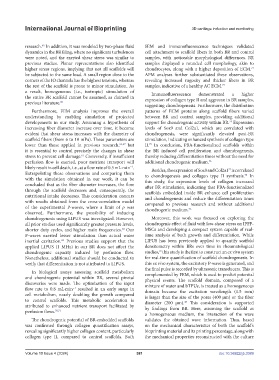Page 389 - IJB-10-4
P. 389
International Journal of Bioprinting 3D cartilage induction and monitoring
research. In addition, it was modeled by two-phase fluid SEM and immunofluorescence techniques validated
66
dynamics in the BR filing, where no significant turbulences cell attachment to scaffold fibers in both BR and control
were noted, and the exerted shear stress was similar to samples, with noticeable morphological differences. BR
previous studies. Planar representations also identified samples displayed a rounded cell morphology, akin to
higher stress regions, implying that not all scaffolds will chondrocytes, along with a higher deposition of ECM.
72
be subjected to the same load. A small region close to the AFM analyses further substantiated these observations,
corners of the IO channels has the highest tensions, whereas revealing increased rugosity and thicker fibers in BR
the rest of the scaffold is prone to minor stimulation. As samples, indicative of a healthy AC ECM. 73
a result, homogeneous (i.e., isotropic) stimulation of Immunofluorescence demonstrated a higher
the entire BR scaffold cannot be assumed, as claimed in expression of collagen type II and aggrecan in BR samples,
previous literature. 60 suggesting chondrogenesis. Furthermore, the distribution
Furthermore, FEM analysis improves the overall patterns of ECM proteins along scaffold fibers varied
understanding by enabling simulation of projected between BR and control samples, providing additional
developments in our study. Assuming a hypothesis of support for chondrogenic activity within BR. Expression
74
increasing fiber diameter increase over time, it became levels of Sox9 and Col2a1, which are correlated with
evident that shear stress increases with the diameter of chondrogenesis, were significantly elevated post-BR
scaffold fibers (from 6 to 10 mPa). These parameters are stimulation, indicating enhanced synthesis of collagen type
75
lower than those applied in previous research, 61,67 but II. In conclusion, PBA-functionalized scaffolds within
it is essential to control precisely the changes in shear the BR induced cell proliferation and chondrogenesis,
stress to prevent cell damage. Conversely, if insufficient thereby reducing differentiation times without the need for
61
perfusion flow is exerted, poor nutrient transport will additional chondrogenic medium. 76
−1
likely result in cell death, i.e., at a flow rate of 0.5 mL·min . Besides, the expression of Sox9 and Col2a1 is correlated
77
Extrapolating these observations and comparing them to chondrogenesis and collagen type II synthesis. In
78
with the simulation obtained in our work, it can be this study, the expression levels of collagen increased
concluded that as the fiber diameter increases, the flow after BR stimulation, indicating that PBA-functionalized
through the scaffold decreases and, consequently, the scaffolds embedded inside BR enhance cell proliferation
nutritional intake decreases. This consideration concurs and chondrogenesis and reduce the differentiation times
with results obtained from the cross-correlation model compared to previous research and without additional
of the experimental P-waves, where a limit of ρ was chondrogenic medium. 76
observed. Furthermore, the possibility of inducing
chondrogenesis using LIPUS was investigated. However, Moreover, this work was focused on exploring the
all prior studies used significantly greater pressure levels, chondrogenic effect of fluid with low-shear stress on IPFP-
shorter duty cycles, and higher main frequencies. Our MSCs and developing a compact system capable of real-
68
P-waves exerted lesser stimulation than actual water time analysis of both growth and differentiation. While
inertial cavitation. Previous studies support that the LIPUS has been previously applied to quantify scaffold
69
applied LIPUS (1 MHz) in our BR does not affect the densitometry within BRs over time in rheumatological
79
chondrogenic capacity induced by perfusion flow. studies, this study is the first to construct an ex vivo system
Nonetheless, additional studies should be conducted to for real-time quantification of scaffold chondrogenesis. In
verify that differentiation is not attributed to LIPUS. this ex vivo system, the excitatory P-wave is generated, and
the final pulse is recorded by ultrasonic transducers. This is
In biological assays assessing scaffold metabolism
and chondrogenic potential within BR, several pivotal complemented by FEM, which is used to predict potential
physical events. The scaffold domain, composed of a
discoveries were made. The optimization of the input mixture of water and bTPUe, is treated as a homogeneous
flow rate to 0.8 mL·min resulted in an early surge in domain because the excitation wavelength (1.5 mm)
−1
cell metabolism, nearly doubling the growth compared is larger than the size of the pores (400 µm) or the fiber
to control scaffolds. This metabolic acceleration is diameter (200 µm). This consideration is supported
47
attributed to enhanced nutrient transport facilitated by by findings from BR. Here, assuming the scaffold as
perfusion flows. 70,71
a homogeneous medium, the interaction of the wave
The chondrogenic potential of BR-embedded scaffolds validates the obtained wave information. Thus, based
was confirmed through collagen quantification assays, on the mechanical characteristics of both the scaffold’s
revealing significantly higher collagen content, particularly bioprinting material and its printing percentage, along with
collagen type II, compared to control scaffolds. Both the mechanical properties reconstructed with the culture
Volume 10 Issue 4 (2024) 381 doi: 10.36922/ijb.3389

